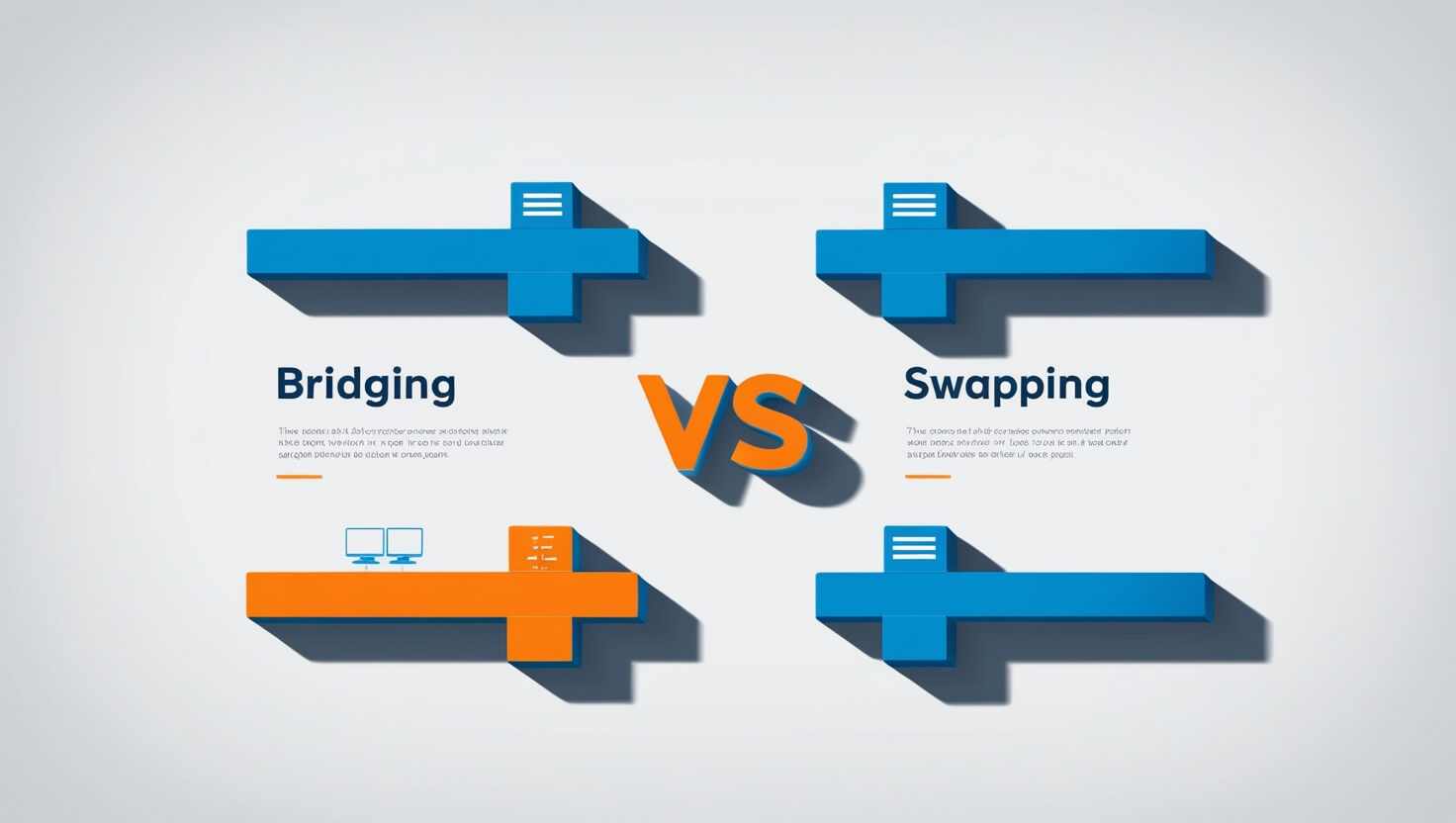I will explain Difference Between Bridging And Swapping in cryptocurrency and blockchain terms. Bridging is like transferring a call from one cell tower to another; it enables cross-chain interoperability.
Swapping is like changing a sim card to a different network; it occurs within the same blockchain. Understanding one of these processes is crucial in efficiently managing your assets or trading tokens in the crypto space.
What Is Bridging?
Bridging in cryptocurrency refers to the ability of transferring assets such as tokens or coins from one blockchain network to another. Blokcahins can be thought of as islands, each governed by its set of unique rules and currency.
Bridging creates a linkage between islands making it possible for assets to flow in and out.

If you have ETH on the Ethereum blockchain and want to use it on Binance Smart Chain (BSC), then a bridge would let you lock ETH on Ethereum while generating a counterpart on BSC (known as wrapped ETH or WETH).
Bridges allow users to utilize their assets on new blockchain sets which is beneficial due to lower fees, exceptional apps, or greater prospects. Bridging simplifies the collaboration of blockchains despite their internal structural differences.
How Does Bridging Work?
In simpler terms, bridging is an automated process.
Consider USDC, a type of stablecoin, on the Ethereum blockchain.
Assume you’d like to transfer USDC to Avalanche, another blockchain.
There is a service provider (or, a bridge) that will begin the process of ‘freezing’ your USDC on Ethereum so it cannot be utilized in the meantime.
Next, the bridge produces a new iteration of USDC on Avalanche that allows you to spend it right away.
This new iteration of a token is generally referred to as “wrapped.” It works like your original token only on a different blockchain. Some bridges function by “burning” the token on the initial chain and issuing the token on the subsequent chain, but the concept remains the same – your asset transfers from one location to another.
Reasons for Using Bridging
Access To New Functionalities: Different blockchains have distinct applications, or they may charge lower fees. If Ethereum’s fees are too high, then you can bridge to Polygon and transact there, at cheaper fees.
Asset Usability: If you have Ethereum tokens, but want to use them in a Solana game, bridging makes that possible.
Increased interoperability: Bridging serves the purpose of connecting disparate blockchains together which wouldn’t be operational without it.
What Is Swapping?
Swapping in cryptocurrency refers to replacing one digital asset with another within the same blockchain network.
It is similar to how you would exchange dollars for euros; however, with cryptocurrency swapping, you utilize crypto tokens.
For example, if you own Ethereum (ETH), and desire to obtain a stablecoin (DAI), you can swap them using a DEX like Uniswap.

Swapping relies on liquidity pools, which are bunches of tokens from users, and a smart contract handles the transaction depending on the existing prices.
For users looking to change their cryptocurrency for another, swapping is easy, efficient, and does not force one to exit their blockchain network. Swapping is ideal for avoiding market trends while trying to diversify.
How Does Swapping Work?
Let us go step by step on how this works:
You posses ether, otherwise known by its token ETH, on the ethereum blockchain.
You wish to have DAI, an additional token within the ethereum space.
You look for a swapping service such as decentralized exchange otherwise knowns as DEX.
You exchange you ETH with crypto DAI at the desired rate.
Swapping are functions performed through automated mechanisms called liquidity pools.
These are a large pools of tokens that have been deposited by whomever so that trading can occur more easily. A small contract, or a portion of the code, determines the amount of DAI to ether and swaps them instantly.
Why Use Swapping?
Alter your assets: Perhaps you think DAI is better as compared to ETH which is why you procured it.
Speedy Interactions: This process is instant and does not require a lot of communication.
Stay on One Chain: Using swapping allows the user to stay on the specific blockchain without it running out.
Example of a Swap
Say you have 1 ETH and you want to buy a token called UNI which is used for the Uniswap platform.
Ether and UNI are both located on the Ethereum network. You connect your wallet to Uniswap and deposit your ETH, which is converted to UNI tokens based on the market rate.
Difference Between Bridging and Swapping
| Bridging | Swapping |
|---|---|
| Moving tokens between different blockchains. | Exchanging one token for another on the same blockchain. |
| Cross-chain interoperability. | Token conversion or trading. |
| Two or more (different chains). | Single blockchain. |
| Locks tokens on the source chain and mints equivalent tokens on the destination chain. | Directly exchanges tokens without involving another chain. |
| Generally slower due to cross-chain validation. | Faster as it occurs on the same chain. |
| Higher due to cross-chain network fees. | Lower, limited to transaction fees. |
| Moving assets between networks (e.g., Ethereum to Polygon). | Converting tokens (e.g., USDT to ETH) on the same network. |
| More complex, involves multiple networks. | Simpler, involves a single network. |
Bridging: Pros & Cons
Pros
Access to New Networks: With bridging, you can use your assets on other blockchains like ETH can be moved to Polygon or Solana to enjoy low fee and fast transactions.
Interoperability: It bonds unconnected blockchains which enhances and adds more value in the crypto ecosystem.
Joined Opportunities: It allows users to access new dApps, staking pools, or NFT markets offered on other chains.
Cost Benefits: Bridging to less expensive blockchains can save you transaction fees as compared to being stuck in Ethereum.
Cons
Bridging Can Be Tricky: Learning wrapped tokens and finding a reliable bridge can be challenging while bridging.
Risk of Hacks: Bridges are a hot spot for hackers, you can lose your assets if a bridge gets exploited.
Bridging Fees: Some bridges will charge for locking and token minting which can be expensive.
Lack of Trust: You are dependent on the security of the bridge and backing of the wrapped token, which can create trust issues.
Swapping: The Pros and Cons
Pros
Easiness: Offering token swaps is effortless. Connect your wallet at a DEX such as Uniswap, choose your tokens, and trade.
Time Efficient: Thanks to liquidity pools and smart contracts, trades are executed instantaneously.
No Intermediary Required: With decentralized swapping, there are no banks or brokers, which means you maintain all control.
Portfolio Changes Are Simple: Changing your portfolio is no hard task, for instance, you can switch ETH to stablecoins when the market is at a low.
Cons
Slippage: During a swap, the price might change especially with tokens of lower popularity. This means you might end up receiving lesser value than you hoped for.
Gas Fees on Some Chains are Absurd: Gas fees for swapping during peak trading activity periods on Ethereum’s network increases.
Liquidity Hazards: When the liquidity for a token pair is low, the swap may terminate midway or have increased expenses due to price effect.
Frauds: If proper care is not observed, fake tokens or rug pulls on DEXs can deceive you into swapping funds for worthless tokens.
Conclusion
Exchanging and bridging are two fundamental functions that crypto has to offer. Bridging enables movement of assets across blockchains, while swapping allows trading of assets within the same blockchain.
Understanding these concepts will open up a world of possibilities such as modifying your crypto portfolio or utilizing applications across multiple chains.
If these concepts intrigue you, and you’re willing to test them, take baby steps at first. A good DEX to start with is Uniswap or SushiSwap, and a reliable bridge is Wormhole or Stargate.
Always remember to do ample research because the space moves very fast and safety should be a priority.









